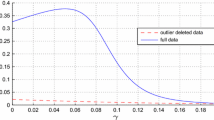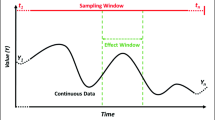Abstract
Clinical trials are often analyzed by examining the means, e.g., what is the mean treatment effect or what is the mean treatment difference, but there are times when analysis of the maximums (or minimums) are of interest. For instance, what is the highest heart rate that could be observed or what the smallest treatment effect that could be expected? While inference on the means is based on the central limit theorem, the corresponding theorem for maximums or minimums is the Fisher–Tippett theorem, also called the extreme value theorem (EVT). This manuscript will introduce EVT to pharmacometricians, particularly block maxima analysis and peak over threshold analysis, and provide examples for how it can be applied to pharmacometric data, particularly the analysis of pharmacokinetics and ECG safety data, like QTcF intervals.












Similar content being viewed by others
Change history
09 July 2021
The original online version of this article was revised: Supplementary file was missing from this article and has now been uploaded.
References
Gumbel EJ (1958) Statistics of extremes. Dover Publications, Mineola
O'Connor T (2018) Fukushima nuclear plant: tsunami wall could have avoided disaster but boss scrapped the plan, employee testifies. Accessed 14 April 2019 from https://www.newsweek.com/fukushima-nuclear-plant-owners-face-trail-one-worlds-most-radioactive-886025
Strom BL, Carson JL, Halpern AC, Schinnar R, Snyder ES, Shaw M, Tilson HH, Joseph M, Dai WS, Chen D et al (1991) A population-based study of Stevens–Johnson syndrome. Incidence and antecedent drug exposures. Arch Dermatol 127:831–838
Bohigian GM (2015) The history of Stevens–Johnson Syndrome and a case study. https://digitalcommons.wustl.edu/cgi/viewcontent.cgi?article=1000&context=historyofmedicine_presentations
Beirlant J, Goegebeur Y, Segers J, Teugels J (2004) Statistics of extremes: theory and applications. Wiley, New York
Southworth H, Heffernan JE (2012) Multivariate extreme value modelling of laboratory safety data from clinical studies. Pharm Stat 11:367–372
Mouton JW, Dudley MN, Cars O, Derendorf H, Drusano GL (2002) Standardization of pharmacokinetic/pharmacodynamic (PK/PD) terminology for anti-infective drugs. Intl J Antimicrob Drugs 19:355–358
Olmo J (2009) Extreme value theory filtering techniques for outlier detection
Benetazzo A, Ardhuin F, Bergamasco F, Cavaleri L, Veras Guimaraes P, Schwendeman M, Sclavo M, Thomson J, Torsello A (2017) On the shape and likelihood of oceanic rogue waves. Sci. Rep 7:Article 8276
Knopoff L, Kagan G (1977) Analysis of the theory of extremes as applied to earthquake problems. J Geophys Res 82:5647–5657
Henry JB III, Hsieh P-H (2010) Extreme value analysis for partitioned insurance losses. Variance 3:214–238
Louangrath P (2016) Stock price analysis under extreme value theory. Posted 14 Jan 2016.
Holmes TP, Huggett RJ Jr, Westerling AL (2008) Statistical analysis of large wildfires. In: Holmes TP, Prestemon JP, Abt KL (eds) The economics of forest disturbances: wildfires, storms, and invasive species. Springer, New York, pp 59–77
Minkah R (2016) An application of extreme value theory to the management of a hydroelectric dam. SpringerPlus. 5:Article 96
Einmahl JHJ, Smeets SGWR (2011) Ultimate 100 m world records through extreme value theory. Stat Neerl 65:32–42
Southworth H, Heffernan JE (2012) Extreme value modelling of laboratory safety data from clinical studies. Pharm Stat 11:367
Southworth H (2014) Predicting potential liver toxicity from phase 2 data: a case study with ximelagatran. Stat Med 33:2914–2923
Bonate PL (2011) Pharmacokinetic: pharmacodynamic modeling and simulation. Springer, New York
Kodra E, Ganguly AR (2014) Asymmetry of projected increases in extreme temperature distributions. Sci Rep 4:5884
Coles S (2001) An introductioin to statistical modeling of extreme values. Springer, London
Malik M, van Gelderen M, Lee JH, Kowalski DL, Yen M, Goldwater R, Mujais SK, Schaddelee M, de Koning P, Kaibara A, Moy SS, Keirns JJ (2012) Proarrhythmic safety of repeat doses of mirabegron in healthy subjects: a randomized, double-blind, placebo-, and active-controlled thorough QT study. Clin Pharmacol Therap 92:696–706
Jenkinson AF (1955) The frequency distribution of the annual maximum (or minimum) of meteorological element. Q J R Meteorl Socs 81:158–171
United States Department of Health and Human Services, Food and Drug Administration, and Center for Drug Evaluation and Research (2005) Clinical evaluation of QT/QTc interval prolongation and proarrhythmic potential for non-antiarrhythmic drugs (E14)
Taubel J, Prasad K, Rosano G, Ferber G, Wibberley H, Cole ST, van Langenhoven L, Fernandes S, Djumanov D, Sugiyama A (2020) The effects of fluoroquinolones moxifloxacin and levofloxacin on the QT subintervals: sex differences in ventricular repolarization. J Clin Pharmacol 60:400–408
Florian JA, Tornoe CW, Brundage RC, Parekh A, Garnett CE (2011) Population pharmacokinetic and concentration–QTc models for moxifloxacin: pooled analysis of 20 thorough QT studies. J Clin Pharmacol 51:1152–1162
Gilleland E, Ribatet M, Stephenson AG (2013) A software review for extreme value analysis. Extremes 16:103–119
Dutang C, Jaunatre K (2020) CRAN task view: extreme value analysis. https://cran.r-project.org/web/views/ExtremeValue.html
Gilleland E, Katz RW (2016) extRemes 2.0: an extreme value analysis package in R. J Stat Softw 72:1–39
Ribatet M, Dutang C (2019) Package 'POT': generalized Pareto distribution and peaks over threshold. https://cran.r-project.org/web/packages/POT/POT.pdf
Author information
Authors and Affiliations
Corresponding author
Additional information
Publisher's Note
Springer Nature remains neutral with regard to jurisdictional claims in published maps and institutional affiliations.
Supplementary Information
Below is the link to the electronic supplementary material.
Rights and permissions
About this article
Cite this article
Bonate, P.L. The application of extreme value theory to pharmacometrics. J Pharmacokinet Pharmacodyn 48, 83–97 (2021). https://doi.org/10.1007/s10928-020-09721-0
Received:
Accepted:
Published:
Issue Date:
DOI: https://doi.org/10.1007/s10928-020-09721-0




